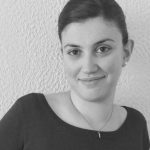Maria Laura Delle Monache: a Franco-American journey in traffic flow control
 Researcher with the NeCS team, Maria Laura Delle Monache has just been awarded the “France-Berkeley Fund award for high-achieving younger researchers”, along with Samitha Samaranayake (Cornell University, PhD UC Berkeley). The prestigious Fund is thereby rewarding the researcher’s commitment to forging links between France and the United States.
Researcher with the NeCS team, Maria Laura Delle Monache has just been awarded the “France-Berkeley Fund award for high-achieving younger researchers”, along with Samitha Samaranayake (Cornell University, PhD UC Berkeley). The prestigious Fund is thereby rewarding the researcher’s commitment to forging links between France and the United States.
Maria Laura took part in the optimal reroute strategies for traffic management Inria@SiliconValley associate team ORESTE (2012-2016) between Paola Goatin (Inria Sophia Antipolis) and Alex Bayen (UC Berkeley). In 2016, she joined the Inria NECS research team in Grenoble, also involved in an Inria@SiliconValley associate team with UC Berkeley on control and Forecasting in transportation networks: COMFORT (2014-2016).
What is the France-Berkeley Fund award?
Maria Laura Delle Monache: This prize aims to encourage a research project carried out by a French researcher and a researcher from Berkeley, California, and is awarded to collaborations that continue over time. I have been working with the University of Berkeley since 2012. During my thesis, which was supervised by Paola Goatin (Inria’s Opale team in Sophia Antipolis), I was able to participate in research with PhD students in the United States, thanks to the France-Berkeley Fund, and the collaboration has continued ever since. And that is why, together with Samitha Samaranayake, we received this award. It was presented to us at the Collège de France in Paris on 7 June.
What are your relations with the United States and with Berkeley?
My field is the modelling of transport systems, a highly-developed subject in the United States. This therefore led me to mix with American researchers very early on in my career: during my thesis, as I have just mentioned, and through Oreste, an associate team between Inria and the University of California, Berkeley. As a result I spent long periods at Berkeley. I also did my postdoc in two years at Rutgers University in New Jersey. Today, I am a researcher with the NeCS team, in Grenoble, and I am again part of another associate team, Comfort, with the University of Berkeley.
What does this award mean for you?
It is wonderful recognition, because it is not always easy to travel so frequently and so far. It is a complicated choice. However, I believe that collaborations between several researchers from several countries are essential in order to advance research. As a researcher, working abroad makes it possible to access other skill sets. You also discover different ways of tackling things, and this is very enriching. I am therefore very proud to promote this idea via this award. Moreover, on a personal level, I think I will continue my career in France but, of course, still continue to work closely with the United States.
What does your research consist of, and what is the contribution of the Berkeley researchers?
I am a mathematician, and I carry out modelling for the control and optimisation of traffic flow, in particular motorway access and re-routing issues. On the Inria side, we have designed macroscopic models, i.e. traffic models with partial differentiated equations. Then, with the Berkeley engineers, we have carried out large-scale simulations in order to see if our models could be applied to real-life situations. As an applied mathematician, the collaboration with Berkeley allows me to work with engineers who are more specialised in transport; our associate team is therefore multidisciplinary.
What subjects are you going to work on next?
I am continuing my research on the modelling and control of traffic flow. However, I am going to try to further study the impact of autonomous vehicles on traffic flow. The idea is to understand what will happen when we have mixed traffic – with autonomous and traditional vehicles. It is obvious that, with the roll-out of autonomous vehicles, traffic flow dynamics will be turned upside down. Our aim is to try to understand how all of this will work and to devise new control strategies. It is a big challenge for the years to come!